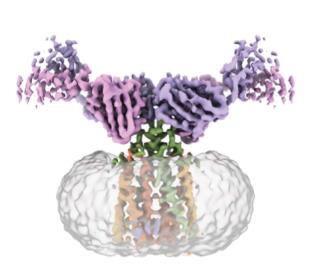The picture shown above is a ‘flower-vase’ plot* of the molecular interaction between Rituxan and CD20. The grey ‘vase’ represents a micelle which stabilizes the CD20 dimer in vitro; in vivo, CD20 is embedded in the B cell plasma membrane. The yellow ‘root’ represents the transmembrane domains of the CD20 dimer, and the green ‘stem’ represents the extracellular domain of the CD20 dimer. The pink ‘flowers’ represent the two IgG Rituxan molecules that complex with the ‘stem’ domain of the CD20 leading ultimately to death of the B cell.
Molecular modeling as shown above is beginning to reveal information about the differences in the mechanisms of action of various monoclonal anti-CD20 antibodies such as rituximab (RTX; Rituxan) and obinutuzumab (OBZ; Gazyva).
Edited text below has been lifted from the paper.
CD20-targeted therapies revolutionized the treatment of B cell malignancies and autoimmune disorders, starting with the monoclonal antibody (mAb) rituximab (RTX; Rituxan), which was the first approved therapeutic mAb for cancer and continues to be the benchmark for secod- and third-generation mAbs. Although all anti-CD20 mAbs act by depleting B cells, they use at least four distinct mechanisms:
-direct cell death
-Fc receptor effector functions through antibody-dependent cellular cytotoxicity
-phagocytosis
-complement-dependent cytotoxicity (CDC).
Each therapeutic antibody varies in its ability to trigger each pathway and there is as yet no molecular-level understanding of why this is the case, but these distinct functional effects have been useful in categorizing anti-CD20 mAbs into either Type I or Type II.
Rituximab is the prototypical Type I mAb, characterized by high CDC activity and the ability to cluster CD20 into lipid rafts. Other Type I mAbs include ocrelizumab [OCR] and ofatumumab [OFA;].
Type II mAbs such as obinutuzumab (OBZ; Gazyva) and tositumomab (Bexxar) exhibit low CDC activity and lack the ability to localize CD20 into lipid rafts but induce higher levels of direct cell death.
The paper presents hypotheses for differences seen in the activities of Type 1 and Type 2 mAbs.
Science 13 Mar 2020:
Vol. 367, Issue 6483, pp. 1224-1230**
science.sciencemag.org/cont...
gardening-girl***
*a name assigned by me - if there can be waterfall plots, why not flower vase plots? I just came in from the garden. I think that "flower pot plot" is a better name for that kind of plot. Vases usually don't have roots! What do you think?
**If anyone is interested, PM me and I can send the PDF, but be warned, although the molecular models are beautiful, the paper is written for structural biologists, of which I am not one!
***Up all night following an IVIG infusion and tired of reading about coronavirus. The latest issue of Science had this article, and I was drawn to the models.
